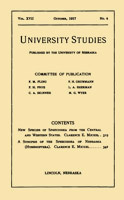University Studies of the University of Nebraska
Date of this Version
April 1914
Abstract
The sedges (Family Cyperaceae) are grass-like plants, but easily distinguished from the true grasses (Poaceae) by the following characteristics: culms solid, pithy, cylindrical, trigonous or flattened. Grass culms by contrast are mostly hollow and cylindrical. Sheaths not open lengthwise opposite the leaf blade, tightly enclosing the culm. Spikes simple or compound, mostly subtended by leaflike bracts, which are sometimes longer than the culm. Spikelets one- to many-flowered, each flower subtended and sometimes embraced by a single short herbaceous or scarious bract or scale, the most characteristic mark of this family. Fruit an achene, trigonous, lenticular, or plano-convex; in the genus Carex only, it is enclosed in a herbaceous sac called the perigynium.
Like grasses, they grow in all kinds of soil from the wettest to the driest, in the densest shade and on the open prairie, from the tropics to the limits of vegetation in latitude and altitude. Many are especially hardy, and flourish in the altitudes where grasses are few, and start in the spring when pastures are still bare, affording short feed for stock when it is most needed. On the average, they are not as valuable for hay and pasturage as the grasses, which is plainly shown by the fact that man has never found one that seemed worthy of cultivation for agricultural purposes, in rivalry with the grasses, which constitute the most valuable family of plants for the use of man in civilization.


Comments
Published in UNIVERSITY STUDIES, vol. XIV, no. 2 (April 1914), pp. 145-165. Published by the University of Nebraska.